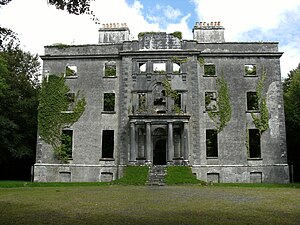Carnacon
Carnacon
Ceathrú na gCon | |
|---|---|
Townland | |
| Country | Ireland |
| Province | Connacht |
| County | County Mayo |
| Elevation | 25 m (82 ft) |
| Population (2006) | |
• Total | 713 |
| Irish Grid Reference | M193768 |
Carnacon or Carrownacon[1] (Irish: Ceathrú na gCon, meaning 'Quarter of the Hounds') is an area in central County Mayo in Ireland. It is situated about 12 miles (19 km) from Castlebar, and is about 8 miles (13 km) from Claremorris and Ballinrobe. The 2006 National Census shows a population of 713 people and 255 houses respectively.
Background
A rural agricultural and picturesque village, Carnacon is situated on the shores of the renowned mayfly fishing lake, Lough Carra. Its location on the edge of the Plains of Mayo makes the area a fertile and natural source for farming. It also is one of the most historical locations in County Mayo. The village has a rich tapestry of stately homes, ringforts, historical and archaeological sites. Doon archaeological peninsula and various ring forts are but a small example of these. The village has a parish church, national school, community centre, grocery store and two traditional pubs. Carnacon Ladies GAA Football team is well known in the GAA world.
History
Moore Hall built by George Moore between 1792 and 1795. It was home to George Moore, novelist, and John Moore, who was President of the short-lived Republic of Connacht.[2] The Moore family won the Chester Cup in England in 1846, with a horse called Coranna. The horse was trained locally and the winnings went towards assisting the local community during the famine. The house was burnt down in the 1920s by the Irish Republican Army; its remains are still intact.
Towerhill House[3] was home to the sporting Blake family, who were a substantial landlord family in the west. The Mayo flag originated on this estate in 1885. Clooneen Mill is present on the grounds of Towerhill. Towerhill was sold in the late 1940s and the Land Commission divided the estate between local farmers. Anything of use was taken from the house. Its roof was removed and the house was abandoned. Its remains are still intact.
Carnacon House, built in 1740, was the home of General James McDonnell, a leader in the rising of 1798. It is the only remaining significant home not abandoned and has been owned by a local family since the 1950s.[4]
Burriscarra Abbey was founded in 1298 by Adam Staunton for the White Friar of Carmelite Brothers.
The millennium stone in the centre of the village depicts all of the above which are the different aspects of the community.
Environment
Farming is the main activity in the area. The suitable environment aids a long grass growing season. The area extends over approximately 7,166 acres. 741 acres of this is woodland, owned and managed by Coillte.
Natural features
- Kiltoom Woods
- Lough Carra
- Horseshoe Bats
- Rare Bird species
Heritage sites
- Burriscarra Abbey
- Castlecarra Castle
- Moore Hall
- Cloneen Mill
- Towerhill House
- St Patrick's Well
- Mass Rock
- Ringforts
- Mayo Flag Origins
Community Organisations
- Carnacon Community Development Associations
- Ladies Club
- Pastoral Council
- Lough Carra Group Water Scheme Co-Op Society Ltd.
- National School Board of Management
- Pioneers Abstinence Association
- Carnacon I.F.A Branch
- Graveyard Committee
Notable People
- Cora Staunton, Ladies Gaelic Footballer
- George Henry Moore, statesman, provider of famine relief[5]
- George Augustus Moore, Irish novelist and part of the Irish Literary Revival
- General James Joseph McDonnell, 1798 rebel leader and barrister
- John Moore, statesman, 1798 rebel leader and former President of Connacht
- Colonel Maurice George Moore CB, Irish soldier, author, politician and a Senator in the Seanad
- Ian O Reilly , Actor in International Emmy Award Winning TV show Moone Boy . (Moorehall)
Pictures
 |
 |
 |
References
- ^ http://www.logainm.ie/Viewer.aspx?text=carnacon&streets=yes
- ^ http://www.waterfordmuseum.ie/exhibit/web/Display/article/4/16/?lang=en
- ^ http://landedestates.nuigalway.ie/LandedEstates/jsp/property-show.jsp?id=404
- ^ http://landedestates.nuigalway.ie:8080/LandedEstates/jsp/property-show.jsp?id=335
- ^ http://www.con-telegraph.ie/history/mayo-history/398-george-henry-moore-1810-1870

